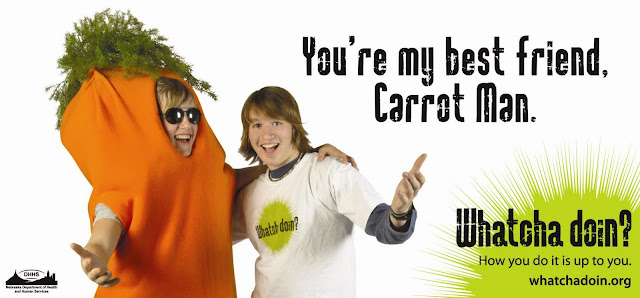The Nebraska Department of Health and Human Services’ “Whatcha doin?” high school wellness campaign encourages teenagers to eat more fruits and vegetables and get more physical activity. The 2010-2011 campaign reaches over 9,000 students in 13 Nebraska high schools in 10 health districts.
As the Whatcha doin? campaign coordinator, I recruit schools for the program, communicate with teachers and students directly, produce campaign materials, order incentives, plan and purchase media, and manage the $15,000 campaign budget.
In addition, I communicate with the Nutrition and Activity for Health team at DHHS about the campaign and with the Centers for Disease Control and Prevention as necessary, including submitting a news piece about the campaign to the CDC on behalf of DHHS.
The campaign has grown exponentially and has received increased interest from past years; the 2010-2011 campaign spanned the entire length of the state, from Blair in the east to Kimball in the west.
Because the 2010-2011 Whatcha doin? campaign had acheived such large reach, the tradition of doing in-person campaign pitches to the schools at the beginning of the school year was no longer feasible.
To accomodate the campaign’s reach, I wrote and directed a campaign pitch video that would be used statewide in each of the 13 Whatcha doin? schools for the 2010-2011 campaign and for future years.
I wrote the pitch video in a way that would allow any school to simply put in the video and watch it to understand what the Whatcha doin? campaign is all about. I negotiated for the video to be filmed at one of the existing Whatcha doin? schools with students involved in the campaign. After filming and final editing, I then presented the pitch video to the Nutrition and Activity for Health Program at DHHS and to agency administrators and received approval for use.
With a tight $4,000 media budget, I negotiated between cable and outdoor advertising companies to devise a plan that reached all 13 schools in the program with some sort of traditional media. I drafted media contracts and acted as the liason between DHHS and the media companies to ensure contracts were signed and deadlines were met.
These billboard designs appeared in five Nebraska towns; Lincoln, David City, Kearney, Kimball, and Omaha.
Traditional media buys such as PSAs were made to support campaign messages outside of school and create more community-wide interest in the campaign.
The Nebraska Action for Healthy Kids Summit draws over 300 students, health professionals, teachers, and wellness advocates together to discuss the current state and future of school wellness.
I constructed the Whatcha doin? booth at the Summit and organized several of our 2010-2011 Whatcha doin? schools to present about the campaign at student round table sessions.







